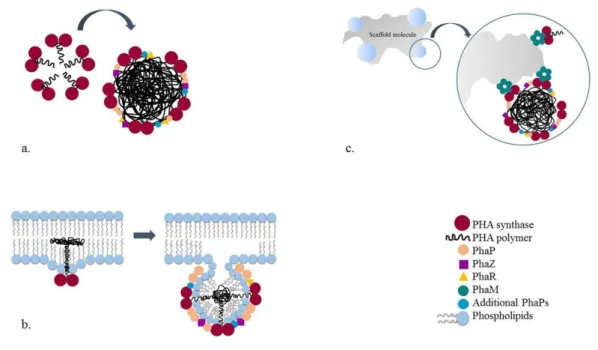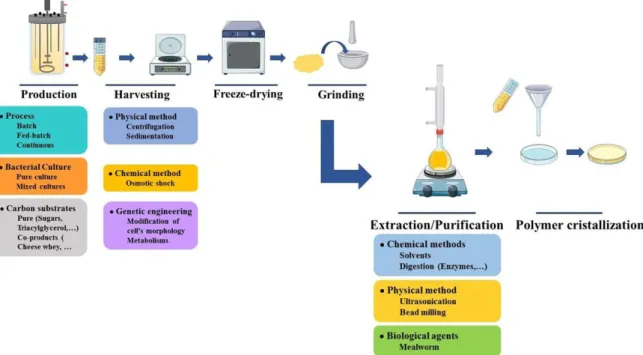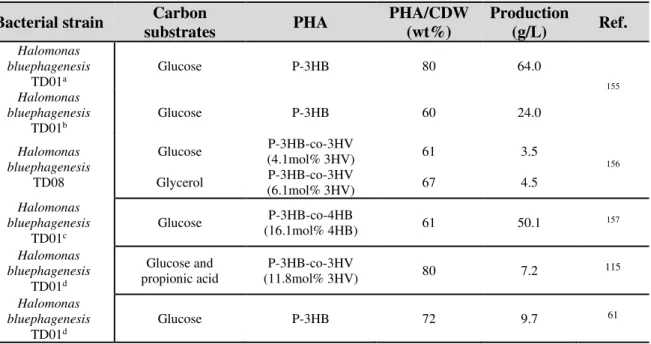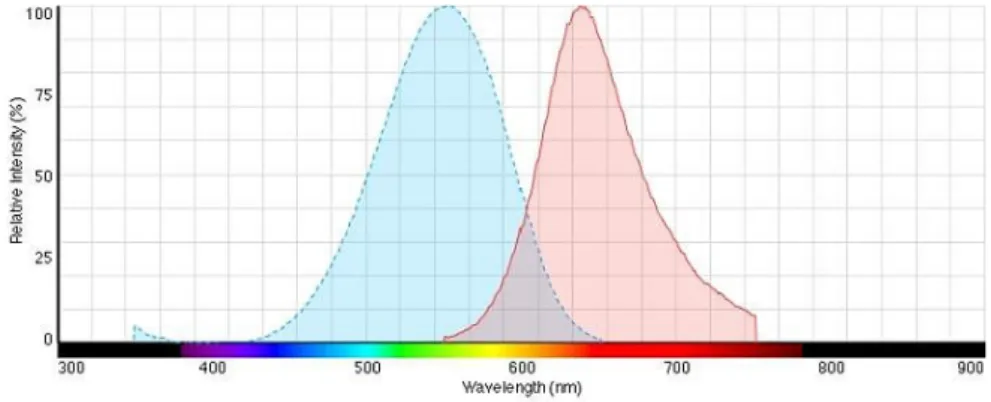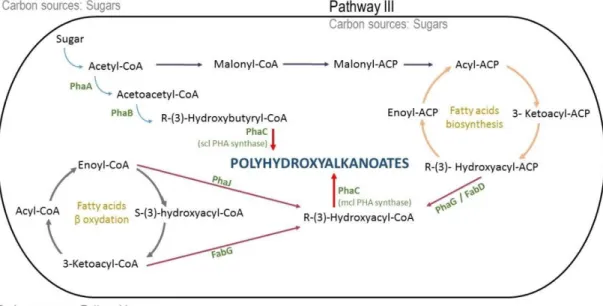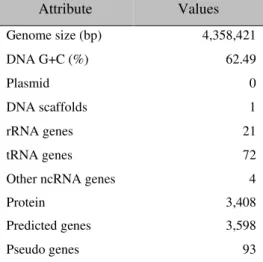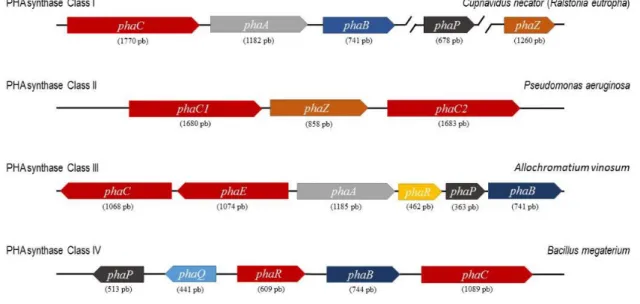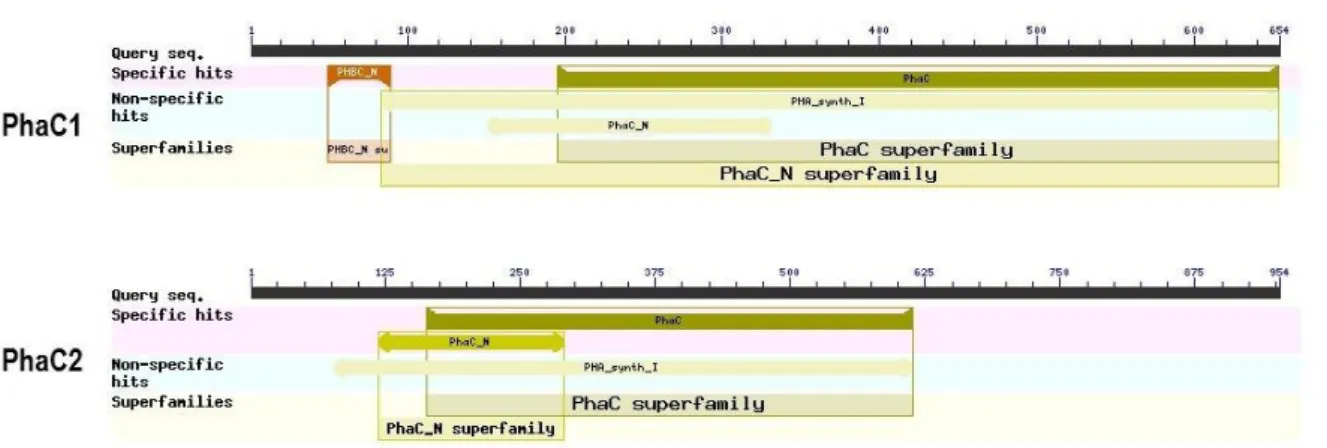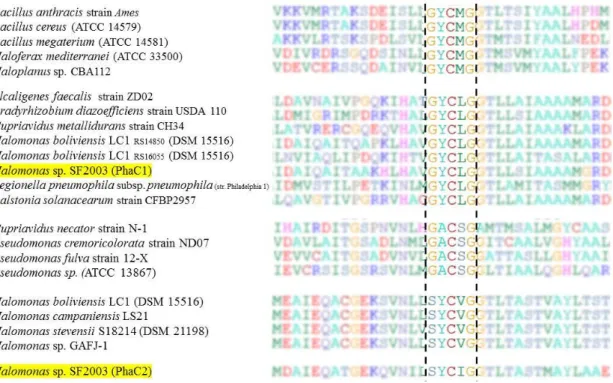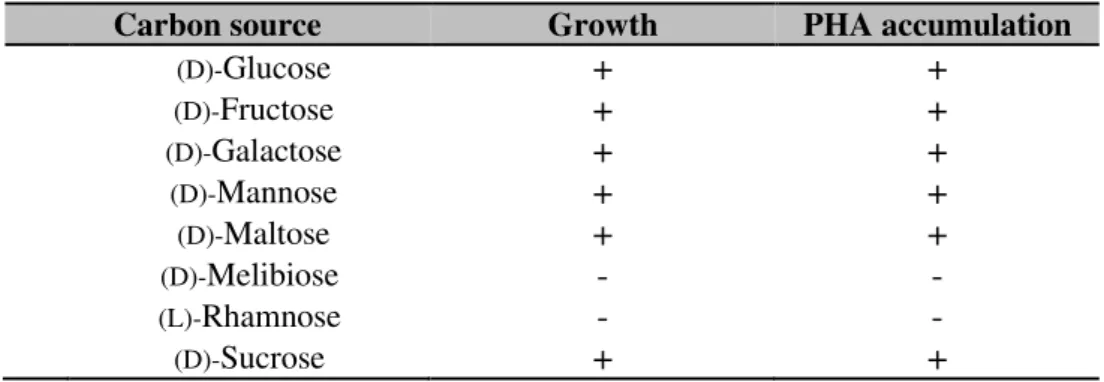HAL Id: tel-03105778
https://tel.archives-ouvertes.fr/tel-03105778
Submitted on 11 Jan 2021
HAL is a multi-disciplinary open access
archive for the deposit and dissemination of sci-entific research documents, whether they are pub-lished or not. The documents may come from teaching and research institutions in France or abroad, or from public or private research centers.
L’archive ouverte pluridisciplinaire HAL, est destinée au dépôt et à la diffusion de documents scientifiques de niveau recherche, publiés ou non, émanant des établissements d’enseignement et de recherche français ou étrangers, des laboratoires publics ou privés.
Study of Halomonas sp. SF2003 biotechnological
potential : Application to PolyHydroxyAlkanoates
(PHA) production
Tatiana Thomas
To cite this version:
Tatiana Thomas. Study of Halomonas sp. SF2003 biotechnological potential : Application to Poly-HydroxyAlkanoates (PHA) production. Biomaterials. Université de Bretagne Sud, 2019. English. �NNT : 2019LORIS542�. �tel-03105778�
T
HESE DE DOCTORAT DE
L’UNIVERSITE
BRETAGNE
SUD
C
OMUEU
NIVERSITEB
RETAGNEL
OIREECOLE DOCTORALE N°602
Sciences pour l'Ingénieur
Spécialité : Génie des procédés et Bioprocédés
Par
Tatiana THOMAS
Étude du potentiel biotechnologique de Halomonas sp. SF2003 :
Application à la production de PolyHydroxyAlcanoates (PHA).
Thèse présentée et soutenue à Lorient, le 17 Décembre 2019 Unité de recherche : Institut de Recherche Dupuy de Lôme Thèse N° : 542
Rapporteurs avant soutenance :
Sandra DOMENEK Maître de Conférences HDR, AgroParisTech
Etienne PAUL Professeur des Universités, Institut National des Sciences Appliquées de Toulouse
Composition du Jury :
Président : Mohamed JEBBAR Professeur des Universités, Université de Bretagne Occidentale Examinateur : Jean-François GHIGLIONE Directeur de Recherche, CNRS
Dir. de thèse : Stéphane BRUZAUD Professeur des Universités, Université de Bretagne Sud Co-dir. de thèse : Alexis BAZIRE Maître de Conférences HDR, Université de Bretagne Sud Co-dir. de thèse : Anne ELAIN Maître de Conférences, Université de Bretagne Sud
« Failure is only the opportunity to begin again more intelligently. »
Henry Ford
« I dettagli fanno la perfezione e la perfezione non è un dettaglio. »
Leonardo Da Vinci
Remerciements
Pour commencer, mes remerciements s’adressent à l’Université de Bretagne Sud et Pontivy Communauté qui ont permi le financement et la réalisation de cette thèse entre l’Institut de Recherche Dupuy de Lôme et le Laboratoire de Biotechnologies et Chimie Marines.
Mes remerciements vont, également, aux membres du jury, Sandra DOMENEK, Maître de conférence HDR à l’Institut des Sciences et Industries du vivant et de l’Environnement, AgroParisTech et Etienne PAUL, Professeur des Universités à l’Institut National des Sciences Appliquées de Toulouse, d’avoir accepté de rapporter ce manuscrit. De la même manière, je remercie Mohamed JEBBAR, Professeur à l’Institut Universitaire Européen de la Mer, et Jean-François GHIGLIONE, Directeur de Recherche CNRS à l’Institut d’Océanographie Microbienne d’avoir accepté de faire partie de ce jury.
Cette thèse, au sujet pluridisciplinaire, a pu être réalisée grâce à la collaboration de Stéphane BRUZAUD, Alexis BAZIRE et Anne ELAIN. Chacun, à sa manière, a su m’apporter l’aide et les outils nécessaires pour l’appréhender et la réaliser du mieux possible. Tout d’abord, je voudrai remercier Stéphane BRUZAUD, de m’avoir accordé sa confiance. Le dynamisme et l’envie continuelle d’avancer m’ont sortie de ma zone de confort et ont permis la réalisation de nombreuses choses. Alexis, d’être venu me chercher une première fois, en 2013 pour intégrer la filière Biotechnologies, et une seconde fois, en 2016, pour cette thèse. Ton optimisme et ta bonne humeur, à toutes épreuves, m’auront été plus qu’utiles tout le long de cette aventure, sans oublier ta disponibilité, ton aide et tes conseils. Enfin, Anne, ta bienveillance, ton recul et ton regard posé m’ont également beaucoup aidée à voir les choses sous un autre angle. Tes nombreux conseils, ta minutie et nos discussions m’ont aussi énormément apporté et ont été très précieux.
Une thèse est l’occasion de continuer à développer des compétences techniques et cela grâce à des personnes, qui de part leur écoute, leurs expériences, leurs compétences et leur patience, apportent énormément. Je pense tout particulièrement à Magali LE FELLIC, Kristen DONNART et Antoine KERVOELEN, mes trois ingénieurs de choc. Chacun son domaine d’expertise, parfois éloigné de mon sujet d’étude, mais tous autant que vous êtes vous avez su m’accorder du temps, m’aider et me soutenir. Magali, le temps partagé dans le bureau, nos nombreuses discussions (scientifiques ou non), ton dynamisme et ta bonne humeur vont me manquer ! Merci également au LBCM et à toute son équipe ainsi qu’à l’IUT de Pontivy d’avoir accepté d’héberger mes expériences dans leurs locaux pendant de nombreuses heures. Bien évidemment, la thèse n’aurait pu avoir lieu sans l’aide précieuse des personnels adiministratifs. Je remercie donc vivement Marie LE GOFF, Nolwenn LE CLOAREC et Claire CONSEIL de leur aide durant ces trois années.
La thèse est une aventure à part entière qui réserve de nombreuses surprises et, quoi qu’il arrive, on en ressort changé. Tout le monde nous prévient, trois ans ça passe très vite. On dit « Oui, oui, je sais », en y croyant qu’à moitié et un jour on « se réveille » et c’est dejà la fin…
Un encadrement de thèse partagé entre deux laboratoires et quatre sites conduit forcément à la rencontre de nombreuses personnes, sans qui cette expérience n’aurait, clairement, pas été la même…
L’équipe du LBCM : Dalyal (mon complice des mauvais coups, certains ne nous pardonnerons jamais je pense…), Émilie, Fabrice, Julie, Alexandra, Florence, Pierre et Laure merci pour tous les bons moments passés ensembles. Une pensée également pour Tiffany, Maëlle et Sophie. Albane, ma partenaire d’étude de toujours, ou la persévérance incarnée. Qui aurait pensé au début du DUT qu’on en serait là aujourd’hui ? Deux caractères différents mais un point commun : l’exigence. Les heures passées ensemble à manipuler, à échanger au sujet de la thèse (ou de tout et de rien) sont plus que précieuses à mes yeux. Tu as toujours été présente, dans les bons moments, comme dans les moins bons, sans toi rien n’aurait été pareil. Une chose qui va me manquer plus que les autres ? Ton regard ! Malheur à ceux qui ne savent pas le déchiffrer et comprendre ce qui va se passer ensuite. Surtout ne change pas ! Évidemment, comment ne pas penser aux garçons du LBCM. Mathieu, le plus microbiologiste des chimistes ! Ton espièglerie et ta sagesse légendaires font de toi quelqu’un d’unique. Toutes les discussions, les crises de rires et les à côtés m’ont « appris » à relativiser et à relâcher la pression. Merci pour tout ! Florian, ton flegmatisme, tes blagues et toutes nos discussions tirées par les cheveux (et qui bizarrement finissaient souvent autour de la cuisine) me manqueront, reste comme tu es ! Merci aussi à Guigui de m’avoir accompagnée, en partie, certaines nuits de manips et pour toutes les pâtisseries (surtout les tartes au citron triple supplément de meringue !).
L’équipe de l’IRDL, « mon » laboratoire, à Lorient ou Pontivy. Pas toujours très à l’aise, voir un peu perdue, quand j’ai débarqué dans ce laboratoire dédié à l’ingénierie des matériaux. Chaque membre a aidé à mon intégration et m’a accordée du temps pour m’expliquer son domaine de recherche. Je vous remercie donc tous énormément.
J’ai une pensée toute particulière pour les Doctorant(e)s de l’équipe, ou non, et pour mes collègues de bureau. Victor G., Chloé, Florent, Yohann, Mathilde, Théo, Adrien, Lucile, merci pour les moments passés ensemble au labbo et en dehors. Mes collègues du bureau « bloc de l’Est », Pierre et Mikaël. En trois années on en a eu des moments mémorables… Pour le bien de tout le monde je les garderai précieusement pour moi mais je ne les oublierai pas. On retiendra surtout les phrases maladroites de certains et la neutralité d’autres qui donnaient toujours des moments cultes ! J’espère ne pas vous avoir trop tyrannisés avec mes envies de ménage et vous remercie pour tout. Je n’oublie pas celles et ceux qui étaient là aux débuts, Compositic et les nouveaux qui prennent la relève !
Un grand merci au Professeur Kumar SUDESH et les membres de l’EcoBiomaterialLab de m’avoir acceuillie durant trois mois. Jiun Yee, Manoj, Carlos, Azlinah, Pei Shze, Marisa, Hua Tiang,
Lim Hui, Sin Yee, Sine, Nabilah, Affiqah, Lina, Mardani, Faizal… merci à vous tous. Les moments passés en votre compagnie, font partis de mes plus beaux souvenirs autant sur le plan de l’échange scientifique que culturel. Terima kasih.
Pour terminer, je voudrai remercier l’ensemble de mes proches et ma famille. L’aide et la compréhension dont vous avez fait preuve sont fantastiques. Ma famille, cette bande de filles/femmes (et un peu d’hommes quand même), malgré mon exigence et la distance vous avez toujours eu un mot d’encouragement ou des petits moments à m’accorder. Toujours présent(E)s, même de loin.
Merci également, à vous deux, ma Team aux yeux bleus, qui m’avez supportée au quotidien (ainsi que mes réveils aux aurores, mon impatience et mon besoin d’activité en permanence). Deux rencontres magnifiques et sans vous rien n’aurait été pareil. Merci d’être toujours là. La suite nous réserve son lot de belles surprises, j’en suis sûre !
Table des matières
Remerciements ... 4
Table des matières ... 7
Préface ... 13
Chapter 1 State of the art ... 17
Halotolerant/Halophilic microorganisms and their biotechnological potential ... 17
Introduction ... 18
I. Microbial communities ... 18
I.1 Habitats and characteristics ... 18
I.2 Taxonomy ... 20
I.2.1 Haloarchaea ... 20
I.2.2 Halophilic and halotolerant bacteria ... 21
II. Biotechnological applications ... 27
II.1 Pigments ... 27
II.2 Enzymes and Compatible solutes ... 29
II.3 Biopolymers ... 30
II.3.1 Polysaccharides ... 31
II.3.2 Polyesters/Polyhydroxyalkanoates ... 32
III. Generalities about Polyhydroxyalkanoates ... 34
III.1 Structure and properties of PHA ... 36
III.1.1 Structure ... 36
III.1.2 Properties ... 38
III.2 Metabolism of PHA ... 38
III.2.1 Molecular organisation ... 39
III.2.2 Metabolic pathways ... 39
III.2.3 Granules of PHA ... 41
III.3.1 Operational modes of Production ... 45
III.3.2 Bacterial cultures ... 47
III.3.3 Carbon substrates... 48
III.3.4 Downstream processing ... 49
III.4 PHA production employing halophilic microorganisms ... 50
III.4.1 Haloarchaea ... 50
III.4.2 Halobacteria ... 51
III.4.3 Genetically engineered halophilic bacteria ... 52
Conclusion ... 54
References ... 55
Chapter 2 ... 71
Matériels et Méthodes ... 71
I Souches bactériennes et conditions de culture ... 72
I.1 Souches et milieux étudiés ... 72
I.1.1 Souches bactériennes ... 72
I.1.2 Milieux ... 72
I.1.2.1 Croissance... 72
I.1.2.2 Tests de croissance en conditions de stress toxique ... 73
I.1.2.3 Tests de production ... 73
I.2 Cinétique de croissance des souches bactériennes ... 73
II Caractérisation bio-informatique de Halomonas sp. SF2003 ... 74
II.1 Séquençage et annotation du génome de Halomonas sp. SF2003 ... 74
II.2 Étude phylogénétique d’Halomonas sp. SF 20003 ... 75
II.3 Étude bio-informatique des PHA synthases ... 75
II.4 Étude phénotypique d’Halomonas sp. SF2003 ... 75
II.4.1 Croissance de Halomonas sp. SF2003 en conditions de stress osmotique et toxique 75 II.4.1.1 Salinité ... 75
II.4.1.2 Composés toxiques : Hydrocarbures Aromatiques Polycycliques ... 75
II.4.1.3 Tests d’antibiorésistance ... 76
III Techniques de biologie moléculaire ... 76
III.2 Réaction de polymérisation en chaîne (PCR) ... 76
III.3 Double digestion ... 78
III.4 Clonage/ligation ... 78
III.5 Conjugaison/transformation ... 79
III.5.1 Transformation des cellules E. cloni® et Escherichia coli S17-1 ... 79
III.5.2 Transconjugaison E. coli S17-1/Cupriavidus necator H16 PHB-4 ... 80
IV Production de PHA ... 81
IV.1 Criblage de sources de carbone assimilables ... 81
IV.1.1 Source de carbone... 81
IV.1.2 Marquage des granules de PHA au Nile Red ... 81
IV.1.2.1 Géloses au Nile Red ... 81
IV.1.2.2 Microscopie confocale à balayage laser ... 82
IV.1.3 Taux de recouvrement ... 83
IV.2 Production ... 83
IV.2.1 Production en erlenmeyers ... 83
IV.2.2 Production en bio-réacteurs ... 83
IV.3 Extraction et purification des PHA ... 84
Références ... 85
Chapter 3 ... 87
Complete genome sequence of the halophilic PHA-producing bacterium Halomonas sp. SF2003: insights into its biotechnological potential. ... 87
Graphical abstract ... 89
Abstract ... 89
Introduction ... 90
I. Results ... 92
I.1. Genome features ... 92
I.2. Identification and phylogenetic study for the classification of Halomonas sp. SF2003 95 I.3. Metabolism ... 97
I.3.2. Polyhydroxyalkanoates production ... 97
I.4. Stress regulation-related proteins ... 101
Discussion ... 105
References ... 107
Chapter 4 ... 118
PHA production and PHA synthases of the halophilic bacterium Halomonas sp. SF2003. ... 118
Graphical abstract ... 120
Introduction ... 120
I. Results ... 121
I.1. In silico study of PHA synthases PhaC1 and PhaC2 of Halomonas sp. SF2003 ... 121
I.2. Screening of carbon substrates for PHA production by Halomonas sp. SF2003 ... 123
I.3. Study of PHA synthases ... 130
I.3.1. Cloning of PHA synthases phaC1 and phaC2 of Halomonas sp. SF2003 ... 131
I.3.2. Characterization of PHA production by transformant strains C. necator H16 PHB-4 phaC1 and C. necator H16 PHB-4 phaC2 ... 131
I.3.3. Polyhydroxyalkanoates production in shake flasks ... 135
Discussion ... 137
Conclusion ... 139
References ... 140
Chapter 5 ... 148
Characterization of the Halomonas sp. SF2003 PHA production ... 148
Graphical abstract ... 150
Introduction ... 150
I. Results ... 151
I.1. Optimization of PHA production process ... 151
I.1.1. Response of Halomonas sp. SF2003 growth in function of carbohydrates ... 151
I.1.2. Impact of carbon source and salinity on PHA production by Halomonas sp. SF2003 153 I.1.2.1. Carbon sources ... 153
I.2. Development of a fluorescence based monitoring method... 155
I.2.1. PHA production kinetics monitoring using fluorescence staining ... 155
I.2.1.1. PHA Production using fructose ... 156
I.2.1.2. Production using glucose ... 160
I.2.2. PHA production ... 164
Discussion ... 166
Conclusion ... 168
References ... 169
General conclusion and perspectives ... 173
Préface
De nos jours, l’exploitation des matériaux plastiques (PP, PE, PVC, …) s’est imposée dans tous les secteurs industriels et de la vie courante. Leur faible coût associé à leurs propriétés physico-chimiques (légèreté, durabilité, transparence, …) leur confèrent de nombreux avantages en comparaison des autres types de matériaux (verre, bois, métal,…) et les ont rendu indispensables. La production mondiale n’a, en conséquence, pas cessé de progresser ces dernières décennies et a atteint le niveau record de 359 millions de tonnes en 2018 soit l’équivalent de 11,38 tonnes produites par seconde. À l’heure où la préservation de l’Environnement est une problématique mondiale prioritaire, la production et la fin de vie de ces matériaux soulèvent de nombreuses controverses, leur persistance dans le milieu naturel s’étendant sur des dizaines d’années. Bien que des moyens de préventions et de traitements aient été développés pour limiter la pollution liée à l’utilisation de plastiques (à usage unique), leur accumulation dans la nature, y compris dans les océans, est alarmante. De plus, la majeure partie des plastiques conventionnels étant issus de l’industrie pétrochimique, l’amenuisement des réserves prétrolières pose la question de la pérennité de la production.
La recherche de solutions alternatives, durables et respectueuses de l’Environnement s’est donc intensifiée ces dernières années conduisant au développement des biopolymères et notamment de ceux étant à la fois biosourcés (issus de ressources naturelles renouvelables) et biodégradables tels que les PolyHydroxyAlcanoates (PHA).
Dans le même temps, l’intérêt porté au milieu marin, a orienté naturellement les recherches vers cet environnement, véritable gisement de molécules et/ou de substances aux propriétés spécifiques : lipides, antioxydants ou encore biopolymères dont les exopolysaccharides (EPS) ou les polyhydroxyalcanoates (PHA), produits notamment par des (micro)organismes halophiles.
Fort de ces constats, l’Institut de Recherche Dupuy de Lôme (IRDL) et le Laboratoire de Biotechnologies Marines (LBCM) de l’Université Bretagne Sud, ont développé conjointement des compétences permettant l’exploitation et la valorisation de ressources naturelles, y compris issues du
milieu marin, pour répondre à la problématique du remplacement des plastiques conventionnels par des matériaux biosourcés.
Les travaux présentés dans ce manuscrit se situent à l’interface de ces deux domaines et s’intègrent totalement dans la thématique de recherche de l’équipe « Ingénierie des biopolymères » de l’IRDL dont l’activité se concentre, en particulier, sur la production à façon de PHA. À travers la mise en œuvre de différentes techniques d’étude, allant de la biologie moléculaire jusqu’aux procédés d’extraction, les polymères produits répondent à des critères précis. L’étude menée, ici, vise à caractériser la bactérie marine, Halomonas sp. SF2003, isolée de molusques pêchés sur les côtes bretonnes, en vue d’exploiter son potentiel biotechnologique, et notamment, sa capacité de production de PHA. Des précédents travaux développés au Laboratoire dans le cadre de projets collaboratifs (BIOCOMBA, PHAPACK et BLUECOPHA) axés sur une montée en échelle de la production de PHA, avaient laissé présager du caractère prometteur de cette souche bactérienne.
Le premier chapitre de cette étude dresse un état des lieux de la diversité des (micro-)organismes marins et de leur potentiel pour le secteur des biotechnologies au regard de leurs capacités d’adaptation et de production de composés d’intérêts. Dans un second temps, l’accent est mis sur le potentiel d’une famille de composés, les polyhydroxyalcanoates, qui s’imposent comme une alternative aux matériaux plastiques conventionnels.
Le second chapitre introduit la partie expérimentale en décrivant l’ensemble des techniques mises en œuvre pour la réalisation de cette étude.
La section « Résultats » est présentée en trois chapitres. Le chapitre III relate la caractérisation génétique et métabolique de la souche Halomonas sp. SF2003, le séquençage du génome et son annotation nous ayant permis de classer la souche et de cibler certains phénotypes. Cette partie sert de base à la caractérisation de la souche et de son métabolisme. Le chapitre IV se focalise sur l’étude de la versatilité de la souche vis-à-vis des sources de carbone afin d’identifier les substrats les plus adaptés à sa croissance et à la production de PHA. La compréhension de la biosynthèse des PHA chez Halomonas sp. SF2003 est également approfondie par l’étude des enzymes clés des voies métaboliques empruntées : les PHA synthases PhaC1 et PhaC2. Finalement, le chapitre V étudie l’impact de différents facteurs
(sources de carbone et salinité) sur la production de PHA, et plus spécialement sur la productivité de la souche. Cette partie a également permis d’initier la mise au point d’une méthode de suivi, en temps réel, de la production de PHA.
À termes, l’ensemble des résultats obtenus permettront d’optimiser la production de PHA par
Halomonas sp. SF2003 afin d’exploiter en totalité le potentiel biotechnologique de cette souche.
Une partie des travaux ayant été réalisée en collaboration avec l’équipe du Pr. Kumar SUDESH, de l’EcoBiomaterial Research Lab de l’Université Sains Malaysia (School of Biological Sciences) et un des chapîtres ayant déjà été publié, l’intégralité de la partie résultat de ce manuscrit est présentée sous le format « article », en anglais.
Chapter 1 State of the art
Halotolerant/Halophilic microorganisms and their
biotechnological potential
Introduction
Halophiles and halotolerants are organisms living in saline or hypersaline environment, sometimes considered as extreme environments, and are encountered in the three domain of life: Archaea, Bacteria and Eukarya. Because they produce a diversity of valuable compounds and expose a strong adaptabilty in front of harsh environmental conditions, they are ardently studied for their use in various fields. This report discusses the interest of using halophilic and halotolerant microorganisms in biotechnological process. In a first part, microbial communities and their natural environment will be presented, then some examples of biotechnological applications using halophiles or halotolerant will be exposed. Finally, and based on data descibed in the previous part, a particular interest will be given to PolyHydroxyAlkanoates (PHA). Usually, several studies are still carried out in order to demonstrate that the use of halophile/halotolerant bacteria could be an interesting and promising way for a sustainable production of these eco-friendly bioplastics. It will be demonstrated that an important effort is given to find new strains, exploit different by-products, optimize systems and increase yield of production in order to reduce cost of production and facilitate PHA extraction and purification steps.
I.
Microbial communities
I.1
Habitats and characteristics
Hypersaline environments are characterized by a concentration of salts higher than 10-12%, caused by dissolution of minerals. These environments are widely distributed and include saline soils, inland salterns and aquatic habitats like saline lakes, salty marshy places, seas or marine salterns 1,2.
They are considered as representative of extreme environments because normal cell physiology cannot withstand the strong salt concentrations leading to considerate (micro-)organisms leaving inside, also, as representative of the primitive (microbial) population 3,4. Indeed saline environments represent a
source of (micro-)organisms, named halophiles or halotolerants, that can belong to the three domain of life: Archaea, Bacteria/Prokarya and Eukarya and expose interesting properties 5. Organisms living in
hypersaline environments are qualified of extremophilic because of their adaptibility in front of constraining living conditions like high/low temperature, low oxygen availability, alkaline pH, or presence of heavy metals/toxic compounds 4,6–8. Therefore, populations found in these environments are
of great interest and are strongly studied for biotechnological applications. In this review, we will only discuss only about halotolerant and halophilic microorganisms belonging to Archaea and Bacteria domains.
Isolation and identification of microorganisms from these environments require special enrichment technics, physiological and biochemical characterization but also special genotyping4.
Numerous studies have been conducted to understand metabolic adaptation of halophilic microorganisms in front of these environments and, consequently, different classifications have been proposed. The most widely used is based on the optimal growth of microorganisms according to salt concentration 2,4,6,7 .
Accordingly, four categories of microorganisms have been defined depending on their salt concentration tolerance:
- “Non-halophiles bacteria”, which have the best growth in media with salt concentration lower than, or equal to, 0.2 M (1% (w/v)) of NaCl. Several bacteria of this category can also tolerate higher salt concentrations and are named halotolerant,
- “Slight halophiles”, for marine bacteria, which have best growth with salt concentration between 0.2 and 0.5 M (1% to 3% (w/v)) of NaCl,
- “Moderate halophiles” with optimal growing rate for salt concentrations from 0.5 to 2.5 M of NaCl (3% to 15% (w/v)),
- “Extreme halophiles” showing best growth for salt concentration from 2.5 to 5.2 M of NaCl (15%-30%(w/v)) 6,9.
Maintenance of the osmotic pressure on either side of the cell is function of two principal mechanisms depending on the category of the microorganism. Aerobic and halophilic Archaea and anaerobic halophilic bacteria accumulate inorganic ions, like KCl, to obtain a high salt concentration in order to balance the osmotic pressure. This mechanism is also known as « salt-in strategy ». This strategy requires an adaptation of the intracellular chemistry and proteins, including enzymes, to preserve their functionnalities 4,10,11. In comparison, the « salt-out strategy » is used by halophilic or
halotolerant Eubacteria, Eukarya and by some methanogenic Archaea. This second mechanism consists in increasing the intracellular concentration of soluble organic solutes (or osmolytes) like amino acids and/or their derivatives, nitrogen-containing compounds, polyols and sugars and/or to expulse salts out of the cell. Organic solutes are non-ionic and show a high water solubility. Consequently, they do not disturb the cell metabolism. Accumulation of these compounds results from an uptake from the environment or de novo synthesis. The accumulated osmolytes also act for cell adaptation to cold, freezing conditions, heat or dessication and help for stabilization of biomolecules like DNA, enzymes or membranes. These molecules have low molecular weight and are classified into zwitterionic, non charged or anionic solutes. Zwitterionic solutes include amino acids and their derivatives (e.g. glycine betaine, ectoine or hydroxyectoine) whereas non charged solutes involve amino acids or carbohydrates such as N-acetylglutaminylglutamine amide, trehalose or sucrose. Finally, anionic solutes include L-α-glutamate, hydroxubutyrate (HB) and its polymerized form: poly-β-hydroxybutyrate (PHB) which is the main representative of the polyhydroxyalkanoates (PHA) family 4,10,11. Interestingly, a number of these
compounds are used in biotechnological fields for various applications. Examples of such applications, and particularly production of PHA, will be discussed later in this manuscript.
For a long time, only two groups have been differentiated: the moderately halophilic Bacteria and the extremely aerobic halophilic Archaea but recent studies allow isolation and identification of new species, genera or higher taxa 7.
I.2
Taxonomy
I.2.1 Haloarchaea
At the present time and based on data available in the second edition of the Bergey’s Manual of Systematic Bacteriology and on LPSN database 12, Archaea includes a total of 5 phyla, 12 classes and
22 orders. Only the Euryarchaeota phylum includes halophilic Archaea grouped within different orders (Table 1) 4,6,7,13,14.
Halophilic Archaea, also named haloarchaea, are included within the Halobacteria class (formely designated Halomebacteria). They belong to the Halobacteriaceae family within the
Halobacteriales order. Identification and classification of haloarchaea is based on the description of
typical features obtained by the study of phylogenetic characteritics (comparison of 16S rRNA gene sequences), genotypic and phenotypic characteristics (growth using different media and growth conditions) and/or polar lipid analysis. Indeed, haloarchaea produce ether-linked lipids which are typically used as key characteristics for differenciation of the members, especialy at the genus level. The most revelant characteristics of halophilic Archaea are their requirement for high salt concentrations (up to 20-25% of NaCl) and their inability to grow in freshwater media, which result in cells lysis 7. They
are considered as the best adapted prokaryotes to hypersaline environments 6 as they can easily grow
aerobically in media containing 20 to 25 % of NaCl. Additionally, some of them can optimally grow in alkaline medium and are consequently named haloalkaliphilic. Moreover, recent studies of hypersaline environments allow identification of halophilic methanogenic species.
Even if a majority of haloarchaea can grow in presence of oxygen, some of them are strictly anaerobic and obtained their energy by the formation of methane by dismutation of methyl compounds (methyl amines, methyl sulfides or methanol). This group of microorganisms, named methanogenic haloarchaea, is essential in hypersaline environment but only few species have been isolated, or are well described. For the moment, methanogenic Archaea are classified within the class Methanomicrobia of the Euryarchaeaota phylum. They have been described in seven orders (Table 1), but only
Methanosarcinales and Methanomicrobiales orders include halophilic species. Four genera included
methanogenic haloarchaea: Methanohalobium, Methanohalophylus, Methanosalsum and
Table 1: Haloarchaea and Methanogenic Haloarchaea classification.
Based on data of de la Haba et al., 2011 and completed with data from other studies.
I.2.2 Halophilic and halotolerant bacteria
Until now, domain of Bacteria groups 34 phyla which include 77 classes, but only the following phyla include halophilic bacteria: Actinobacteria, Bacteroidetes, Cyanobacteria, Firmicutes, Proteobacteria, Spirochaetes, Tenericutes and Thermotogae. These phyla regroup moderately or extremely halophilic bacteria in contrast to halophilic Archaea which are mainly extremely halophilic species.
Phylum
Class
Orders
Family
Genus/Species
Eurya rcha ea ot a H al obac ter ia (or Ha lom eb act eri a ) H al obac ter ia les Haloarculaceae Haloarcula Halomicrobium Halorhabdus Halosimplex Halobacteriaceae Haladaptatus Halalkalicoccus Halarchaeum Halobacterium Halorussus Natronoarchaeum Natronomonas Salarchaeum Halococcaceae Halococcus H al of erac a le s Haloferaceceae Haloferax Halogeometricum Halosarcina Haloplanus Halopelagius Haloquadratum Halorubraceae Halobaculum Halogranum Halonotius Halorubrum N at ri al ba le s Natrial ba c e a e Halobiforma Halopiger Halostagnicola Haloterrigena Halovivax Natrialba Natrinema Natronobacterium Natronococcus Natronolimnobius Natronorubrum M et hanom icr ob ia Methanosarcinales Methanosarcinaceae Methanohalobium Methanohalophylus Methanosalsum
Halophilic Bacteria include a large number of heterogeneous species including Gram positive and Gram negative cocci or rods which are aerobic or anaerobic with a heterotrophic or phototrophic metabolism. The height phyla (Table 2, 3, 4 and 5) not only include halophilic genera/species but also halotolerant genera/species.
Actinobacteria phylum is divided in 6 classes and 48 families for a total of 218 species representing one of a major phylum of the domain. Among the different classes, only Actinomycetales order, from Actinobacteria class, contains halophilic species inside the following suborders:
Actinopolysporinae, Corynebacterineae, Glycomycineae, Micrococcineae, Pseudonocardineae and Streptoporangineae.
Comparatively, three classes inside the Bacteroidetes phylum contain halophilic species:
Bacteroidia, Flavobacteriia and Sphingobacteriia. For all these classes, only one family containing
halophilic species is described: Marinilabiaceae (Bacteroidia class), Flavobacteriaceae family (Flavobacteriia class) and Rhodothermaceae (Sphingobacteriia class).
Cyanobacteria phylum (also nammed blue-green algae or blue-green bacteria or Cyanophyta) has a taxonomy not clearly defined yet, depending on the followed rules (bacteriological or botanical). Species inside this phylum expose interesting properties and are essential for photosynthesis of their natural environment of origin. Slightly halophilic bacterial species are only described in the
Oscillatoriales order.
Traditionally three classes are described in the Firmicutes phylum: Bacilli, Clostridia and Mollicutes but recently the last one, Mollicutes class, was moved to the Tenericutes phylum (described bellow). Two new classes were added to the phylum: Erysipelotrichi and Thermolithobacteria. This phylum groups heterogenous microorganisms in morphologic and physiologic point of view.
Table 2: Taxonomy of Halobacteria (Part1).
Phylum
Class
Order
Family
Genus or
Species
A ct inob a ct er ia Actinobacteria Act inom yc et a les Actinopolysporaceae Actinopolyspora Corynebacterineae Corynebacterium Glycomycetaceae Haloglycomyces Jiangellaceae Haloactinopolyspora Nocardiopsaceae Haloactinospora Nocardiopsis StreptomonosporaPseudonocardiaceae HaloechinothrixAmycolatopsis
Micrococcales Bogoriellaceae Georgenia Micrococcaceae Nesterenkonia Promicromonosporaceae Isoptericola Prauserella Saccharomonospora Saccharopolyspora Ruaniaceae Haloactinobacterium B act er oi de te s
Bacteroidia Bacteroidales Marinilabiliaceae Anaerophaga
Flavobacteriia Flavobacteriales Flavobacteriaceae PsychroflexusGramella Sphingobacteriia Rhodothermales (or
Sphingobacteriales) Rhodothermaceae (or Salinibacteraceae) Salinibacter Salisaeta C yanob act er ia Unassigned
Chroococcales Unassigned Rubidibacter
Oscillatoriales « Prochlorococcaceae » Halospirulina
Prochlorales Unassigned Prochlorococcus
Fir m icu tes Baci ll i Bacillales Bacillaceae Alkalibacillus Aquisalibacillus Bacillus Filobacillus Gracilibacillus Halalkalibacillus Halolactibacillus Halobacillus Lentibacillus Oceanobacillus Ornithinibacillus Paraliobacillus Pontibacillus Salimicrobium Salinibacillus Salirhabdus Salsuginibacillus Sediminibacillus Tenuibacillus Thalassobacillus Virgibacillus Planococcaceae Jeotgalibacillus Staphylococcaceae Salinicoccus
Clostridia Halanaerobiales Halanaerobiaceae
Halanaerobium Halocella Halothermothrix
Table 3: Taxonomy of Halobacteria (Part2).
Phylum
Class
Order
Family
Genus or
Species
Fir m icu tes C lost ri d ia Halanaerobiales Halanaerobiaceae Halanaerobium Halocella Halothermothrix Halobacteroidaceae Acetohalobium Halanaerobacter Halobacteroides Natrionella Orenia Selenihalanaerobacter Sporohalobacter Prot eob act er ia Alphaproteobacteria Caulobacterales Hyphomonadaceae Hyphomonas Maribaculum Maricaulis WoodsholeaRhizobiales Hyphomicrobiaceae Dichotomicrobium
Rhodobiaceae Rhodobium Rhodobacterales Rhodobacteraceae Antarctobacter Citreimonas Hwanghaeicola Jannaschia Maribius Marivita Methylarcula Oceanibulbus Oceanicola Palleronia Paracoccus Ponticoccus Rhodothalassium Rhodovulum Roseicitreum Roseinatronobacter Roseisalinus Roseovarius Salinihabitans Salipiger Sediminimonas Shimia Sulfitobacter Tropicibacter Yangia Rhodospirillales Rhodospirillaceae Fodinicurvata Marispirillum Rhodovibrio Roseospira Deltaproteobacteria Desulfobacterales Desulfobacteraceae Desulfobulbaceae Desulfocella Desulfurivibrio Desulfovibrionales Desulfohalobiaceae Desulfovibrionaceae Desulfohalobium Desulfovibrio Desulfonatronospira Desulfovermiculus Epsilonproteobacteria Campylobacterales
Campylobacteraceae Arcobacter halophilus
Helicobacteraceae
Sulfurovum lithotrophicum
Sulfurimonas autotrophica
Table 4: Taxonomy of Halobacteria (Part3).
Phylum
Class
Order
Family
Genus or Species
Prot eob act er ia G am m aprot eo bac ter ia
Aeromonadales Aeromonadaceae Aeromonas
Alteromonadales Alteromonadaceae Alteromonas Aestuariibacter Glaciecola Marinobacter Marinobacterium Melitea
Idiomarinaceae Pseudidiomarina Idiomarina Pseudoalteromonadaceae Pseudoalteromonas Psychromonadaceae Psychromonas Cellvibrionales Cellvibrionaceae Gilvimarinus Halieceae Haliea Microbulbiferaceae Microbulbifer Chromatiales Chromatiaceae Halochromatium Marichromatium Thiohalocapsa Ectothiorhodospiraceae Alkalilimnicola Aquisalimonas Arhodomonas Ectothiorhodospira Ectothiorhodosinus Halorhodospira Thioalkalivibrio Thiohalospira Hahellaceae Halospina Halothiobacillaceae H alothiobacillus Thioalkalibacteriaceae Thioalkalibacter Thioalkalispiraceae Thiohalophilus Oceanospirillales Alcanivoracaceae Alcanivorax Halomonadaceae Aidingimonas Carnimonas Chromohalobacter Cobetia Halomonas Kushneria Modicisalibacter Salinicola
Oceanospirillaceae Nitrincola Oleispira « Saccharospirillaceae » Saccharospirillum
Unassigned Salicola
« Nevskiales » «Salinisphaeraceae» Salinisphaera
Pseudomonadales Pseudomonadaceae Pseudomonas
Vibrionales Vibrionaceae Salinivibrio
Thiotrichales Piscirickettsiaceae Thiomicrospira
Unassigned Unassigned
Methylohalomonas Thiohalobacter Thiohalomonas Thiohalorhabdus
Table 5: Taxonomy of Halobacteria (Part4).
Phylum
Class
Order
Family
Genus or Species
Spirochaetes Spirochaetes Spirochaetales Spirochaetaceae Spirochaeta
Tenericutes Mollicutes Haloplasmatales Haloplasmataceae Haloplasma contractile
Thermotogae Thermotogae
Kosmotogales Kosmotogaceae Kosmotoga
Petrotogales Petrotogaceae Marinitoga Petrotoga Thermotogales Thermotogaceae Thermosipho Thermotoga
Inside the Bacilli class (or Bacillales order) various halophilic species have been described in
Bacillaceae, Planococcaceae and Staphylococcaceae families but the Bacillaceae family contains the
highest number of halophilic species.
Proteobacteria represents the most important and phenotypically diverse phylum of the Bacteria
domain and contains an important number of halophilic or halotolerant genera or species. This phylum is strictly composed of Gram-negative species and is divided in 5 classes (Zeta-, Alpha-, Beta-, Delta-,
Gamma- and Epsilonproteobacteria) which are ubiquitous and physiological heterogenous. All the
classes include halophilic species except Betaproteobacteria.
Rhodobacterales, Rhizobiales and Rhodospirillales are composed of moderately halophilic species in
the Alphaproteobacteria class. Halophilic bacteria of Deltaproteobacteria (also nammed Deltabacteria)
are described as strictly anaerobic chemoorganotrophic, chemolithoautotrophic or
chemolithoheterotrophic sulfate-reducing organisms with respiratory metabolism and are classed in different families. Comparatively, inside the Epsilonproteobacteria class only three moderately halophilic species, isolated from hydrothermal environments, have been described: Arcobacter
halophilus, Sulfurovum lithotrophicum and Sulfurimonas autotrophica.
Finally, Gammaproteobacteria phylum contains the largest number of genera, approximately 250, including 51 moderately halophilic species 6,7.
The Oceanospirillales order contains the family with the most important number of halophilic species described until now: Halomonadaceae 15,16. This family is composed of species exposing different
phenotypic characteristic making classification quite difficult in some case. Moreover, the nine genera composing this family are phylogenetically close except the Halomonas genus which is polyphyletic. Hence Halomonadaceae family exposes interesting features, and numerous research have been conducted for its study as well as its members leading to a reconsideration and a reorganization of the family in the 1990’s 17,18.
In comparison with previous phyla, Spirochaetes and Tenericutes phyla contain only few halophilic species: Spirochaeta halophila, S. africana, S. alkalica and S. asiatica and Haloplasma
contractile.
Finally, several moderate, slight or marine species, have been described in Thermotogae phylum. All belonging to Kosmotogaceae, Petrotogaceae or Thermotogaceae families. But actually, Petrotoga
halophila is the only moderately halophilic species clearly identified 6,12.
This part depicted taxonomy of halophilic archaea and bacteria and demonstrated their important representation in different phyla and at the same time represented as an important variety of (micro-)organisms which can be studied. Molecular mechanisms of their adaptation to hypersaline conditions have only recently been studied. Moreover, identification of genes conferring salt resistance, along with the presence in halophiles of novel and stables biomolecules, explain the growing interest of both scientists and industry to study more deeply and to exploit these species. The next section will expose the specific characteristics and properties of these microorganisms and how they provide significant opportunities for biotechnology.
II. Biotechnological applications
The use of biotechnologies in our way of life is inescapable. They are employed for production of added value compounds by bioprocessing from sustainable (co-)products provided by agriculture, environment or industries, used in various domains 19. Even if the most famous known applications are
the production of biopolymers and biofuels, biotechnologies are also exploited for applicatons including production of detergents, food and drink. Research and exploitation of halophiles already started during last century. Regarding physiological features, adaptability and characteristics of halophiles in front of extreme environments (alkalic/acidic, hot/cold or extremely salty) their employment in biotechnology industry seems to be an advantageous solution to overcome important energy and water consumptions that are required by some biotechnological processes 4,9.
II.1
Pigments
Among the important variety of compounds produced by halophiles, including biosurfactants/detergents, biopolymers, enzymes, compatible solutes, some are more studied and yet produced at a large industrial scale.
Since the end of the 19th century and the beginning of the 20th century, haloarchaea have been
identified as responsible for the pink to red coloration of saline lakes and/or highlty salt concentrated ponds of salterns 6. This coloration, observed in animals, plants, algae or microorganisms, is due to
production of yellow-red or orange-red liposoluble pigments called carotenoids. There is more than 750 carotenoids, some of natural origin and others obtained by chemical synthesis, including cathaxanthin, phytoene, phytofluene, lycopene, lycopersene, β-carotene, C50-bacterioruberin and its derivatives
(isopentenyldehydrorhodopin, anhydrobacterioruberin, bisanhydrobacterioruberin or monoanhydrobacterioruberin) 20,21. Bacterioruberin is the main carotenoids produced by haloarchaea. It
is composed of 50 atoms of carbon and can be found as trans or cis isomer as its derivatives 13 (Figure
1). Bacterioruberin have different biological roles in haloarchaea. It acts for protection of DNA and
consequently cells, against ionizing by UV-radiation or hydrogen peroxide (antioxidant activity) demonstrated in Halococcus morrhuae and Halobacterium salinarium’s extracts. Bacterioruberin acts also for cellular membrane reinforcement, by limiting water permeability and increasing rigidity 21,22.
Different species of haloarchaea have been identified as natural producers of carotenoids like Haloferax
alexandrinus that produces canthaxanthin or the green algae Dunaliella salina and D. bardawil which
are already exploited for production of β-carotene 9,23. But usually, only few are cultivated for viable
commercialisation of carotenoids due to the high production costs.
Figure 1: Bacterioruberin.
Another pigment of interest produced by halophiles is the membrane-bound retinal pigment named bacteriorhodopsin 4. This coumpound is a light-driven proton pump which is involved in a
photocycle, initiated by light excitation, leading to proton release outside the cell. This release creates a proton gradient usable for adenosine triphosphate (ATP) generation 4. Bacteriorhodopsin was discovered
in the 1970s in Halobacterium salinarium’s proteome and is qualified as an unusual protein due to its characteristics. Indeed this protein, of approximately 25kDa, tolerates a large range of temperature and does not need high salt concentration, in contrast to other proteins of H. salinarium, to keep its structural stability and activity. Yet bacteriorhodopsin is sold as purple membrane patches but there is no true commercial applications even if use of bacteriorhodopsin seems to be adapted to many different applications like spatial light modulators, artificial retinas 23 or for desalination of seawater 24. The
pigment could be used for conversion of light energy into chemical energy (and also electricity) 4 or for
back conversion of ADP to ATP, allowing production of ATP which is highly necessary for some biotechnological process 24. But one of the most interesting and promising applications is the use of
bacteriorhodopsin as erasable and photosensitive material for optical information recording and processing in holography especially 11.
Carotenoids are produced by numerous halophiles : haloarchaea or halobacteria and count a large variety of pigments exposing interesting properties (strong immune boosting and antioxidant properties
but also protective action against premature ageing) 25. They can be used as additives in baking process
or emulsions, or in cosmetic industry 22,23. Even if the yield of production and downstream process are
very interesting they must be improved to optimize production costs at their maximum. Solutions can be to increase production yield, use of by-product such as nutritive source or transgenic systems (as well as production of β-carotene by Halomonas elongata expressing production genes of Pantoea
agglomerans) 24. Usually the use of these pigments have been poorly studied however in view of the
high demand of carotenoids in cosmetic, food or pharmaceutical industries new studies should be conducted.
II.2
Enzymes and Compatible solutes
Among the important variety of compounds produced by halophiles, a special attention is given to enzymes and compatible solutes. Indeed, enzymes are referred as polyextremophilic and unusual stable proteins due to their intrinsically stability and activity under harsh conditions 25–27. Compatible
solutes, then, could be used for stabilization of (bio-)molecules.
Halophilic microorganisms secrete halophilic hydrolases (proteases, lipases, amylases, esterases or nucleases) able to catalyze reactions under high salt concentrations 28. Currently, glycosyl hydrolase,
protease and lipase represent 70% of sold enzyme. Proteases alone are the most used enzymes, especially in detergents formulations, pharmaceuticals, food processing or waste management 10. Different
halophilic species have been identified as protease producer such as Halobacillus karajensis strain MA-2, Pseudoalteromonas sp., Halobacillus sp. or Chromohalobacter sp. 10,25. Lipase represents also an
important industrial enzyme exploited in detergent formulation or organic synthesis and has been reported to be produced by the moderately halophilic species Salinivibrio sp. 24. Finally, halophilic
amylases, which are commonly cyclomaltrodextrinases, are produced by various halobacteria (Halomonas meridiana, Halobacillus spp., Halothermotrix orenii, Haloarchula sp.S-1 or Micrococcus
halobius) and can also be used in detergent formulation or for waste water treatment 10. But even if a
large variety of halophilic enzymes are produced by different halobacteria there is only few which have found industrial application due to limited requirement for salt-tolerant enzymes. Currently, nuclease H of Micrococcus varians subsp. halophilus is used for production of flavoring agent is one of the few enzymes with industrial applications 24.
In comparison, demand for compatible solutes is quiet more developped. The term compatible solutes refers to zwitterionic, non charged or anionic, low molecular mass compounds allowing adaptation, maintenance and survival of organisms under harsh conditions by providing an osmotic balance 25. These compounds avoid or limit detrimental action of high salt concentration, high
temperature, freezing or dessication on (bio-)molecules (DNA, proteins, …). Additionnaly, some of them expose ability to counteract UV-A effects.
Figure 2: Ectoine. Figure 3: Hydroxyectoine.
This mechanism is considered as one of the main defense of halophiles 10. This class of molecules
includes amino acids (alanine, glycine, proline), sugars (trehalose and sucrose), polyols (glycerol, mannitol, sorbitol), betaine, ectoine and its derivative hydroxyectoine (Figures 2 and 3). Both last ones are the most produced by halophiles in front of high salt concentrations. Degree of halotolerance seems to be linked to type of compatible solutes accumuluted by cells: low salt-tolerant strains, frequently, accumulated sucrose and/or trehalose, moderately salt-tolerant glucosylglycerol while ectoine and quaternary ammonium compounds are found in highly salt-tolerant species. Ectoine was first observed in Ectothiorhodospira halochloris (a haloalkaliphilic photosynthetic sulfur bacterium) before being found, as its derivative hydroxyectoine, in a large variety of species such as Halomonas elongata, H.
salina, H. boliviensis, H. ventosa, Chromohalobacter salexigens, Virgibacillus halodenitrificans or Marinococcus M52. Industrial productions of ectoine and hydroxyectoine are developped using Halomonas elongata and Marinococcus M52, respectively. One biotechnological process, called
« bacterial milking », was developped for production of ectoine with H. elongata and consists to induce excretion of ectoine, to maintain osmotic balance, by transferring bacterial biomass alternatively into low and high osmolarity medium 5,29. Studies have demonstrated that optimization of medium
composition, significantly impacts yield of production 30. Employment of halophilic strain, engineered
or not, could allow production of compatible solutes and their use as proteins stabilizers, dessication protector in medical applications or for skin care protection in cosmetic formulations 4,9,25.
II.3
Biopolymers
Microorganisms, including halophiles, are responsible for production of various biopolymers like polyamides, polyanhydrides, polyesters or polysaccharides, whose majority are extracellular products. They are mainly synthesized to protect cells in front of stressful conditions 31. In natural environment,
biopolymers are completely degraded by depolymerases and hydrolase action making them good candidates for replacement of recalcitrant oil-based polymers. Consequently, bacterial polymers are exploitable in diverse application fields (food industry, pharmaceuticals technology, packaging, bioremediation,…) 32. In this section we will present and describe some of them in order to underlign
II.3.1 Polysaccharides
There are already many studies looking for discovery and exploitation of marine polysaccharides such as agar, agarose, carrageenans and alginates, that are extracted from seaweeds (macroalgaea) 33. But marine bacteria can also produced an important variety of polysaccharides:
structural, intracellular or extracellular polysaccharides also named exopolysaccharides (EPS). This last type of polysaccharides represents another important source of marine polymers with promising or actual applications. Numerous bacterial species have been reported to produce EPS in large amounts 24,
nevertheless only few of these polysaccharides have been yet fully studied 33.They are water soluble
molecules, which may be ionic or non-ionic, literally extracellularly produced by halophilic microorganisms. EPS are composed of very regular units of repeat (branched or not) 4 that can be
sugars including amino sugars (Glucosamine and Galactosamine), pentoses (Arabinose, D-Ribose, D-Xylose), hexoses (D-Allose, L-Fucose, D-Galactose, D-Glucose, D-Mannose, L-Rhamnose) or uronic acids (D-Glucuronic acids, D-Galacturonic acids). They can also contain various organic or inorganic compounds (acetic, phosphoric, pyruvic, sulfuric or succinic acids, phosphate or sulfate) 33,34.
EPS can be considered as protective compounds against adverse conditions and many halophilic species have been described to possess an EPS capsule surrounding cell to protect it. But they are also involved in different processes in marine environment such as bacterial attachment on surfaces, biochemical interaction between cells and absorption of dissolved organic materials 33,35. EPS production has been
described in various halophilic microorganisms like Halobacteria and especially Halomonas species (H.
alkaliantartica, H. anticariensis strain FP36, H. eurihalina, H. maura, Halomonas sp. AAD6, H. ventosae sp. nov.,...) 5,11,24,36,37 or in Cyanobacteria species (Aphanothece halophytica or Cyanospira capsulate) 24,38 but also in haloarchaea (Haloferax mediterranei, Haloferax gibbonsii, Haloarcula strain
T5). Their production can be induced by various environmental factors: salinity, pH, temperature, light intensity, competition for nutriments or for adaptation in front of extreme inhabitats. Consequently their biological functions depend on microorganisms’s environment 39.
EPS produced by Halomonas species are polyanionic with an elevated sulphate content and glucuronic acid 4,38 giving them good gellifying properties. Comparatively, EPS from the haloarchaea,
Haloferax mediterranei, are anionic sulfated acidic heteropolysaccharides exposing good rheological
properties, high viscosity at low concentration and resistance against harsh conditions (temperature and pH) 9,11,24. EPS also expose immunomodulation properties (sulfated EPS can limit virus penetration in
host cells like EPS of A. halophyticawhich inhibit pneumonia caused by influenza virus H1N1 24 or
those produced by H. mauran4), anticancer activy (EPS from Pseudomonas sp. exposing cytotoxic
effects on cancer cell lines MT-4) or bone-healing properties (EPS produced by Vibrio diabolicus)
These properties allow marine EPS to have applications such as surfacting, emulsifying, gellifying, thickening agent in various industries. They can be used in food or pharmaceutical applications but also for oil recovery and bioremediation of heavy metals.
EPS expose interesting properties, as well as those produced by Halomonas almeriensis (emulsification of hydrophobic compounds ; bio-detoxifier, emulsifier or biological agent) 40. Consequently, studies for
optimization of their production and recovery are conducting. Actually, production and recovery process are key points. Indeed, in some cases production yields are low and production of EPS using fermentation process leads to the obtention of a final growth medium revealing a high viscosity. Consequently, recovery of biopolymer is difficult and can be too expensive for the final quantity of EPS. Different approaches are studied, i.e. the use of genetically modified strains or optimization of production parameters. Several studies have been conducted to determine impact of temperature on EPS production by marine strains (members of Colwellia, Hallela and Pseudoalteromonas genera) and demonstrated its key function for increasing production yields 39. Influence of media composition on
biopolymer production was also investigated for different bacterial species (belonging to
Pseudoalteromonas, Pantoea, Halomonas genera) and highlights the importance of this parameter and
the necessity to adapt it to microorganism’s metabolisms.
II.3.2 Polyesters/Polyhydroxyalkanoates
Among biopolymers, microbial polyesters named polyhydroxyalkanoates (PHA) (Figure 4), probably represent the heterogeneous biopolymers of greatest interest.
Figure 4: PolyHydroxyAlkanoates general structure.
PHA are biodegradable and biocompatible storage polymers naturally accumulated by different organisms: Prokaryotes, Bacteria and Archaea. PHA are stored as insoluble inclusions of 0.1-0.5 µm in diameter in cytoplasm 32. PHA granules are carbon and energy reserves, but their composition suggests
a multifunctional role and leads to another way to call them: “carbonosomes” 41.
An important structural diversity has been described for these biopolymers. Indeed, more than 150 different monomers have been reported (Table 6) confering to PHA a wide range of properties 10.
Because they are biodegradable, thermoplastic and elastomeric materials, they are considered as good alternatives for replacement of conventional plastics 11,42–44.
Table 6: Common monomer units of PHA.
Class Pendant R group Name Abbreviations
scl -PHA CH3 Methyl Poly(3-Hydroxybutyrate) P-3HB CH2CH3 Ethyl Poly(3-Hydroxyvalerate) P-3HV m cl -PHA CH2CH2CH3 Propyl Poly(3-Hydroxyhexanoate) P-3HHx (CH2)3-CH3 Butyl Poly(3-Hydroxyheptanoate) P-3HHp (CH2)4-CH3 Pentyl Poly(3-Hydroxyoctanoate) P-3HO (CH2)8-CH3 Nonyl Poly(3-Hydroxydodecanoate) P-3HDD
Due to these interesting characteristics, their use can be considered in various field such as plastics processing industry (extruded or moulded products and packing or mulching films) for food packaging, consumer goods 45 or for medical applications (cardiovascular products, surgical sutures,
wound dressing, tissue scaffolds, artifacts/implants, bone replacement, …) 5,32,46,47. They can also be
used as biodegradable carriers of valuable compounds (hormones, drugs or biocides) 48,49. Exploitation
of PHA in agricultural/environmental fields, as in situ bioremediation of contaminated sites or treatment of municipal wastewater, can also be considered 50,51. Finally, PHA-producing bacteria have been
recently used for the enhancement of crop productivity by improvement of nitrogen fixation 52.
Currently, only few companies worldwide can furnish large amount of PHA such as Biomer (Germany) 53,54, Bio-on (Italy) 55, Imperial Chemical Industry (U.K), Metabolix,Inc. (U.S.A) 56 or Telles
LLC (U.S.A) 57. The main restriction for development of their marketing is their final cost. Indeed,
production of PHA still requires high-priced carbon substrates as well as expensive downstream processing leading to an overall production cost 5 to 10 times more expensive (7 to 10 €/kg) than those of conventionnal plastics 13,32.
One of the tracks studied in order to reduce final cost of PHA is the use of halophilic/halotolerant strains since 10:
- Seawater can be exploited as producing medium, limiting freshwater consumption, - Hight salt concentration limits external contamination,
- Simple carbon substrates can be used,
- Limited downstream processes are required as osmotic shock may be sufficient to lyse bacteria, depending on the species,
All these characteristics allow reduction of production costs but still demonstrate some limitations. For example, high salt concentrations can be harmful for equipment (leading to corrosion) or coupled productions can complicate downstream process.
First description of PHA-producing Haloarchaea was reported in 1972 and 1986, in Haloferax
mediterranei and Haloarcula marismortui , before being reported in different Haloarchaeal and
Halobacterial species such as Haloaquadratum walsbyi, Halogeometricum borinquense, Natrinema
altinense 46, Cobetia marina, Halomonas boliviensis LC1 , H. elongata DSM 2581, H. salina, Halomonas sp. TD01 58–61.
Production by Haloarcula and Haloferax species are the most studied and efficient haloarchaea to procuce various PHA 13. Indeed, Haloferax mediterranei has demonstrated ability to produce both
poly-3-hydroxybutyrate (homopolymer, P-3HB) and poly-poly-3-hydroxybutyrate-co-3-hydroxyvalerate (P-3HB-co-3HV) and production of terpolymer poly-3-hydroxybutyrate-co-3-hydroxyvalerate-co-4-hydroxybutyrate (P-3HB-co-3HV-co-4HB) has also been reported 62.
Additionnaly to haloarchaea species, halobacteria are also deeply studied for PHA production and especially Halomonadaceae. In this family, numerous PHA-producers were identified as well as
Halomas aquamarina ATCC 14400, H. boliviensis DSM 15516, H. cupida CECT 5001, H. elongata
CECT 4279, H. eurihalina ATCC 49336, H. meridiana DSM 4225, H. pantelleriensis DSM 9661, H.
variabilis DSM 3051 or H. ventosae DSM15911. Like haloarchaea, halobacteria are able to produce
different type of PHA (P-3HB, P-3HB-co-3HV,…).
III.
Generalities about Polyhydroxyalkanoates
Polyhydroxyalkanoates are biopolyesters detected in various eukaryotic (plants, animals,…) and prokaryotic organisms (bacteria and archaea) which show thermal, mechanical and physicochemical properties similar to those of conventional pretroleum-based plastics 43,44,63. This part will only deals
with generalities about bacterial PHA (production, characteristics, properties and applications).
First osbservation was reported in 1926 by Lemoigne in Bacillus megaterium, a Gram positive bacterium, before being observed in various Gram positive (like Bacillus sp., Clostridium sp.,
Actinomycetes sp., Corynebacterium sp., Staphylococcus sp. or Streptomyces sp.) and Gram negative
(Acinetobacter sp., Alcaligenes sp., Chromobacterium sp., Haemophilus sp., Nitrococcus sp.,
Pseudomonas sp.,…) species including halobacteria and haloarchaea species (Haloferax mediterranei, Halomonas boliviensis, Halomonas elongata,…). To date more than 300 species are able to produce
PHA are water insoluble compounds accumulated into the bacterial cytoplasm as one to ten granules (Figure 5) 64,65. PHA production occurs during bacterial growth between end of exponential
growth phase and beginning of stationary phase under nutrionnal imbalance (excess of carbon and a limitation of another essential nutrients like nitrogen, oxygen or phosphorus) 65,66 or in response to an
environmental stress (harsh physical conditions) 32,67–69.
Figure 5: Transmission Electron Micrograph of P-3HB-co-3-HV granules in Cupriavidus necator H16. (http://www.ecobiomaterial.com)
PHA granules serve mainly as carbon and energy reserve but others biological functions have been described 41. For instance, it has been reported that PHA can limit alteration of cellular components
as protein or RNA and can enhance resistance against dessication, thermal or osmotic shock, UV irradiation…41. Others studies have demonstrated horizontal transfert of PHA metabolism related genes
by bacterial species in order to resist to stressful environment 70. In Bacillus cereus, Clostridium
botulinum or Azotobacter vinelandii 41,49, PHA production has been reported to be linked to various
cellular mechanisms like spore or cyst formation, synthetic nitrogen fixation or to prevent production of acidic compounds of cellular metabolisms 49,64,71. In Methylarcula marina, M. terricola and
Photobacterium profundum, β-hydroxybutyrate accumulations have been reported when extracellular
concentration of NaCl increases, suggesting a potential osmolytic role of β-hydroxybutyrate or its polymer 72. PHA in the form of oligomer, meaning 100 to 200 units of monomer, and more precisely as
oligo-PHB, have been detected complexed with polyphosphate and calcium ions (PHB-Ca-polyphosphate complexes) in cellular membrane of different PHA-producing species or not as Bacillus
subtilis or Escherichia coli. Additional research have demonstrated that PHB-Ca-polyphosphate
complexes are linked to competence of bacterial cells 64. Actually, it is clear that biological functions
of PHA can not be limited to simple storage compounds and need to be deeply studied to demonstrate their importance in various species. Indeed, considering PHA granules’s composition, it is suggested that they can have other different biological functions 49,64 and consequently PHA granules are also
